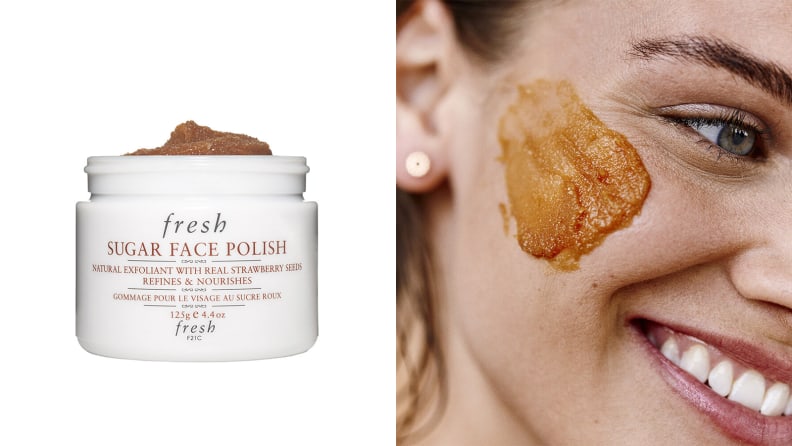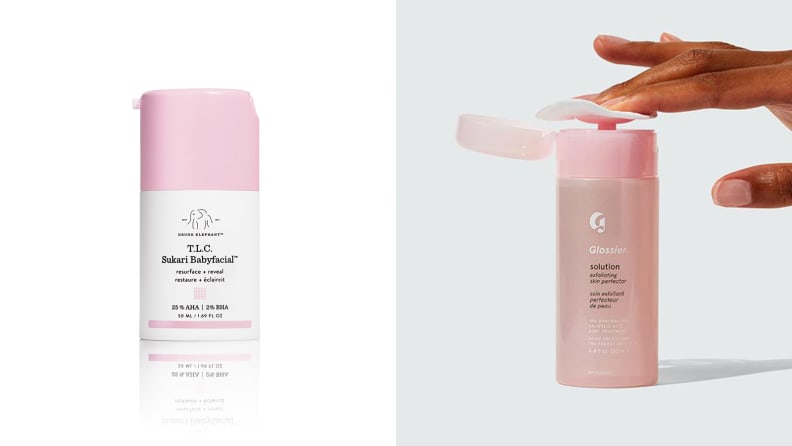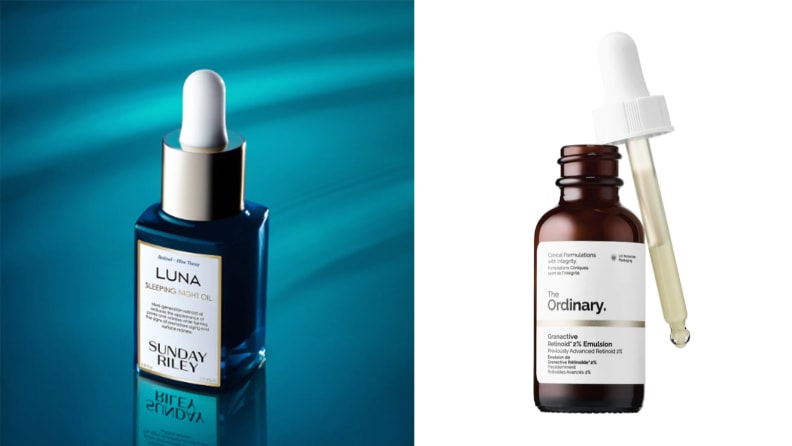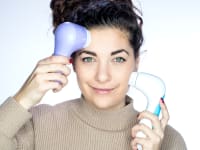Your skincare routine might be damaging your face—here’s why
What you should know before you pick up Kylie Jenner’s walnut scrub
 Credit:
Getty Images / Extreme Photographer
Credit:
Getty Images / Extreme Photographer
Recommendations are independently chosen by Reviewed's editors. Purchases made through the links below may earn us and our publishing partners a commission.
When you first hear the term “exfoliation,” you may think about the hand soaps with microbeads in them or the loofa you keep hanging in you shower. These scratchy-feeling products supposedly help our skin—but how? And why?
Why should you exfoliate your face?
Exfoliation is the process of removing dead skin cells from the surface of the epidermis, or the outermost layer of the skin. It’s proven to brighten a dull complexion, fade dark spots quicker, and make the skin appear more youthful because it causes the skin cells to turn over faster.
There are two different mechanisms you can use to remove the dead skin: physical—also called manual—that sloughs the skin with friction, and chemical, which involves ingredients that dissolve the bonds holding dead skin cells together, allowing them to shed more efficiently. We spoke with a dermatologist to learn how each method works and how to choose which is right for your skin.
What is physical exfoliation?
Physically removing dead skin cells requires applying pressure to the skin using a rough texture. You can apply a facial scrub product containing particles similar in texture to sand, such as micro-beads, grated nut shells, sugar, or salt. The other method is to use a tool, such as a washcloth (the texture of the terry counts as an exfoliant!) or a cleansing brush, or visit a spa to have a trained aesthetician use a microdermabrasion or laser wand.
The trouble with physically exfoliating is that you can easily damage your skin if you apply too much pressure, use a particularly harsh product, or do it too often. The big buzz phrase around exfoliation is “micro tear,” which we saw come up in the lawsuit against St. Ives Apricot Scrub, and again when Kylie Jenner released her walnut scrub. Dr. Clarissa Yang, the chief of dermatology at Tufts Medical Center in Boston, says that, depending on the particle size, how sharp the particles are, and how much pressure you put on your skin, you can create a little to a lot of damage. “You can create barrier disruption,” she says. “Barrier function is incredibly important in making sure that your skin remains healthy.”
The “barrier” in question is the outermost layer of the skin that consists of cells and lipids and acts as a protective shield against harmful bacteria, fungus, viruses, and other microorganisms. However, finely crushed walnut shells are not solely to blame. Too much pressure from any physical exfoliant can disrupt your skin barrier.
What is chemical exfoliation?
Rather than scrubbing your face with exfoliating particles to remove dead skin cells, chemically exfoliating products use retinoids (compounds derived from vitamin A), alpha hydroxy acids (water-soluble acids made from sugar fruits) or beta hydroxy acids (oil-soluble acids made from natural substances like willow bark) to do the work for you. Yang says these acids break up the bonds that hold the dead skin cells together, which causes the skin to shed its dead cells. You apply them to clean skin, in the form of lotion, cream, or serum, and wait for results.
The downside to this method is that it may not be as immediate or gratifying. You’ll likely notice improvements in skin texture after continued use. You also don’t have control over how well or how quickly they work, as you would physical exfoliants, because you’re not doing the scrubbing—just applying them and letting them do their thing.
Which type of exfoliation is right for you?
While scrubs or tools might be more appealing, Yang recommends chemical exfoliants to her patients, as there’s less room for error when they’re used as directed. “I think that people get really excited about trying to get rid of whatever they’re getting rid of, or anti-aging, and then they go overboard,” she says.
While you can integrate both types of exfoliants into your routine, it’s better to stick with one, especially when you’re first introducing exfoliation to your skin. “It’s definitely possible to have both, but when you have chemical exfoliation on board, you already have less dead layers of skin so you are more susceptible to damage with the physical exfoliation,” Yang says.
The key to beginning exfoliation is to go slowly. “I think once or twice a week is actually a good starting point—seeing what your skin can tolerate. You’ll be able to escalate. It’s better to do that than [exfoliate] everyday and then find out three days later that you’re a mess.”
Also very important: Be extra diligent about wearing sunscreen while your routine involves exfoliating because the skin is extra-sensitive to the damaging effects of UV radiation after shedding its outer layer.
When should you not exfoliate?
Along with carefully and slowly introducing exfoliants into your skincare routine, it’s also important to know when to stop using them. As a general rule, you should discontinue and speak to your doctor if your face is stinging, turning red, or breaking out in a rash.
For a preventative measure, you should also discontinue exfoliating before waxing or any procedure that could harm the skin. “You want to stop [using] exfoliants a few days before any kind of procedure because you’re just [more] sensitive when exfoliating,” Yang says.
Choosing a physical exfoliator
So you’ve decided you want to try a physical exfoliator because (despite what Dr. Yang recommends), you enjoy the sensation of scrubbing and buffing the skin. Now what? Your at-home options: a facial scrub (some of which also contain chemically exfoliating ingredients) or using your usual face wash with either a washcloth (rather than your fingers, as usual) or a cleansing brush. These products use different mechanisms but achieve the same results, so it’s all in your preference.
Choosing a chemical exfoliator
Chemical exfoliators have more nuance to them, as these creams and serums may contain AHAs, BHAs, retinoids, or even a combination of all three. AHAs are considered better for pigmentation issues on the skin, so if you are dealing with dark spots, consider trying a formula containing them, which appear on ingredient lists as lactic, glycolic, malic, citric, tartaric, or mandelic acids.
If you have blackheads or whiteheads, also referred to as open and closed comedones, BHAs, which appear as salicylic or citric acid, may be a better option for your skin.
If you have mature skin or you are looking for anti-aging ingredients, consider choosing a product with retinoids, which help to diminish the appearance of fine lines and wrinkles. These often appear in over-the-counter products as retinol, vitamin A, or retinyl.
If you want a gentle facial scrub

The Fresh Sugar Face Polish buffs away dead skin.
For a physical exfoliator that leaves your skin feeling fresh and clean without stripping it of moisture, try the Fresh Sugar Face Polish Exfoliator. The scrub uses brown sugar to buff away dead skin, strawberries with vitamin C to brighten the complexion, and plum seed and grapeseed oil to hydrate. Use a gentle touch, in light circles, to exfoliate without damage.
Get the Fresh Sugar Face Polish Exfoliator at Sephora for $25
If you want a cleansing brush for boosting your usual routine

The Eterbeauty Facial Brush comes with five detachable heads for exfoliating your whole body.
These electric facial tools exfoliate the skin while also removing dirt, oil, and leftover makeup from your day, and you can use them with your usual facial cleanser. While you can buy manual face brushes, an electric one takes the guesswork out of how much pressure to apply—just running the brush head lightly over your skin is all you need. We love Etereauty Facial Brush for its super-soft bristles and its five interchangeable brush heads that work for other parts of the body, as well. Plus, it’s affordable at a fraction of the cost of higher-end ones.
Get the Etereauty Facial Brush on Amazon for $19.99
If you want AHAs for lightening dark spots

The Sunday Riley Good Genes All-In-One Lactic Acid Treatment and the The Ordinary Lactic Acid 10% + HA use AHAs to exfoliate.
For a serum with alpha hydroxy acids, go with the cult-favorite Sunday Riley Good Genes All-In-One Lactic Acid Treatment, which uses—you guessed it—lactic acid to exfoliate. In addition to smoothing your skin’s texture, it claims to brighten the appearance of dark spots with licorice and lemongrass extracts, and soothe redness with prickly pear extract.
For a more affordable option, The Ordinary makes a serum that also uses lactic acid to exfoliate. The serum claims to reduce any signs of inflammation and sensitivity from the exfoliation using purified Tasmanian pepperberry.
Get the Sunday Riley Good Genes All-In-One Lactic Acid Treatment at Sephora for $158
Get the The Ordinary Lactic Acid 10% + HA at Sephora for $6.80
If you want BHAs for treating acne

The Drunk Elephant T.L.C. Sukari Babyfacial 25% AHA + 2% BHA Mask and the Glossier Solution use BHAs to remove dead skin cells.
With 200,000 “loves” on Sephora, the Drunk Elephant T.L.C. Sukari Babyfacial uses a blend of AHAs and BHAs, including glycolic, tartaric, lactic, and citric acids, to speed up how quickly skin sheds old cells and produces new ones. The serum also uses gram and chickpea flour to give dull skin a nice glow and pumpkin ferment extract to aid in exfoliation.
At a less expensive cost, Glossier’s Solution uses salicylic acid to treat acne and AHAs, such as glycolic and lactic acid, to lighten dark spots and scars from previous blemishes. For best use, apply the toner to a cotton pad and glide across your face.
Get the Drunk Elephant T.L.C. Sukari Babyfacial 25% AHA + 2% BHA Mask at Sephora for $80
Get the Solution Face Exfoliator and Skin Perfector at Glossier for $24
If you want retinoids for anti-aging

The Sunday Riley Luna Retinol Sleeping Night Oil and the The Ordinary Granactive Retinoid 2% Emulsion use retinol to exfoliate the skin.
If your main focus is anti-aging, a retinol like the Sunday Riley Luna Retinol Sleeping Night Oil is an A+ addition to your skincare regime. The lightweight oil uses trans-retinol ester to minimize the appearance of wrinkles and fine lines, promote skin elasticity, and exfoliate for smoother skin. Blue tansy and German chamomile lessen the appearance of redness and chia seed oil reduces fine lines by maintaining moisture in the skin.
A more affordable retinol is The Ordinary’s Granactive Retinoid 2% Emulsion, which uses granactive retinoid, an advanced form of retinoid that improves signs of aging on the skin. The serum claims that using an advanced form of retinoid will have the effects of retinol without the irritation sometimes associated with it.
Get the Sunday Riley Luna Retinol Sleeping Night Oil on Sephora for $105
Get the The Ordinary Granactive Retinoid 2% Emulsion at Sephora for $9.80



